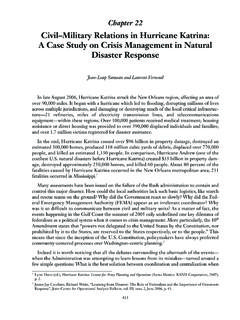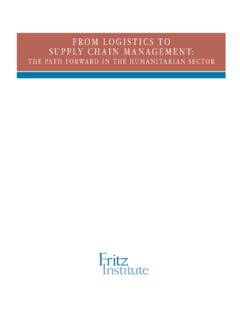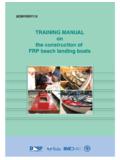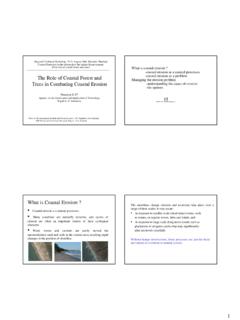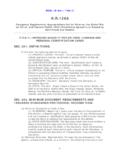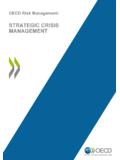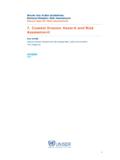Transcription of Response to the 2004 Tsunami: An International Perspective
1 Response to the 2004 tsunami : An International PerspectiveHoward Roy WilliamsIt is virtually axiomatic to begin a conversation regarding lessons learned and best practicesby discussing the usually expected failure in applying the former, and making an assumptionthat the latter concept has substantial validity; in other words, that best practices can be deter-mined and applied across the board. In taking a backwards look at the tsunami of December2004, and the nature of the Response on an International and local scale, it must be acknowl-edged that lessons learned more often translate into lessons observed and that best prac-tices may only be understood and promulgated on a disaggregated basis.
2 Arguably, this is not aconclusion applicable only to the tsunami because of the scale of the regional impact with thecomplications inherent in a disaster of that magnitude. A regional Perspective can begin andend at the water s edge or at a national boundary. In the case of early warning systems, how-ever, there was a regional consensus that establishing such systems was an urgent is important to note, however that a retrospective examination such as this necessarilyincludes a carefully chosen degree of obfuscation.
3 For example, this analysis is presented inglobal terms as if institutions and collectives in general operate as monolithic entities. This isuseful for purposes of presentation but certainly overlooks the realities of individual actionsand initiatives redounding to the benefit of organizations but with little relation to them assuch. An impediment to understanding the area of humanitarian assistance, simply put, maywell be its ad- hoc nature and the tendency to examine its operation taking this aspect as animmutable fact.
4 The Indian Ocean TsunamiThe earthquake triggering the tsunami , with a magnitude of , struck off the west coast ofSumatra, Indonesia. The tsunami affected 12 countries in south and southeast Asia and thenortheastern coast of Africa. This aftermath of the earthquake affected Indonesia, Sri Lanka,India, and Thailand, to differing degrees, but with an overall massive loss of life exceeding twohundred thousand persons. It created, in addition to the immediate consequences of the disas-ter, long- term issues of resettlement and reconstruction.
5 Further, in the case of Aceh, Indone-sia and Sri Lanka, the Response was affected by ongoing conflict. This is noteworthy, as theconflict issues affected the Response in relation to the roles of International actors. As with most events of significant magnitude, the tsunami captured worldwide attention. Itsaftermath remains newsworthy but to a significantly smaller audience, assuming one is out theregion where it occurred. We have a two- part but related scenario to review. There is the eventwith its effect on the lives of those in immediate danger, and a worldwide and often stunnedChapter 21401public, including those with particular anxieties over the fate of friends and relatives.
6 Thenthere is what follows and slowly unfolds as attendant political and social issues are worked magnitude and extent of the impact of the tsunami led to an immediate outpouring ofdirect assistance, with credible offers of more to come. The United States initially pledged$350 million accompanied by a pledge of military support. This was almost immediately fol-lowed by an additional request for $600 million. The initial contribution of $ million bythe European Union was quickly increased. Private contributions were of similar some cases, such as that of the non- governmental organization (NGO) M decins sans Fron-ti res(MSF), the level of contributions exceeded their program requirements as well as theability to utilize the funding.
7 MSF then announced this quite publically, requesting the suspen-sion of contributions to them for tsunami relief. This unusual declaration highlighted the levelof support emanating from the public and governments as well as International groups from must be acknowledged that a critical aspect of this disaster was the fact that the area was aworldwide tourist Mecca. There were few countries whose citizens were not visiting in one ofthe affected areas, with anxious relatives abroad whose attention immediately focused on theirtelevision screens, radios, the internet, or newspapers.
8 In that respect, this was a transnationaloccurrence which, at least temporarily, transcended usual regional concerns and disputes. Further, in the case of Indonesia, the outpouring of apparently apolitical aid was seen bysome as ameliorating the presumed growing polarization between the west and Muslimnations. This certainly seemed to be an outcome; perhaps in the short term and on the basis ofperceptions not importance of the issue of coordination of International relief efforts was immediatelyrecognized by the Association of Southeast Asian Nations (ASEAN).
9 An emergency meetingwas held in Jakarta within two weeks of the event. The agenda focused on increasing contribu-tions and coordinating relief Actors and Their RolesIt would be difficult to identify a group not involved in the Response . In addition to thenational governments and their militaries, civil society organizations, foreign militaries, privateenterprise, and International NGOs also played key roles. The resources and logistical expertise available to and utilized by national militaries wascritical in the early days, particularly in the areas of security, communications, and movementof relief supplies.
10 However, there were limiting factors affecting their Response . The Indone-sian military, for example, had few helicopters in the region. However, the aircraft carrierwas in the region and its 25 helicopters began flying missions within days of the disaster. Evenwith added capacity, insufficient transportation assets were a major element, as well as the criti-cal factor that the military and their families were among the victims. The contribution of civil society organizations, including NGOs, church groups, and othercommunity organizations, notably, the national Red Cross/Red Crescent societies, was extraor-402 Raising the Bardinary and many would argue that these local groups represent a little understood or appreci-ated component of the overall Response .
